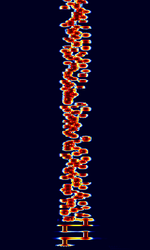VOICE
OLIVIA based Modes: Olivia - Contestia - RTTYM - PAX - VOICE
VOICE is a MFSKMultiple Frequency Shift-Keying mode developed by Patrick Lindecker F6CTE in 2006, and was derived from Olivia. It was designed for blind or partially sighted amateur radio operators where all received characters can be pronounced.
VOICE was derived from the 8 tone, 62.5 baudBaud (unit symbol Bd) is the unit for symbol rate or modulation rate in symbols per second. Olivia mode, but with a 32 bit vector instead of a 64 bit vector, a different set of characters and a different speed.
VOICE uses 8MFSK with a shift of 21 HzHertz (Hz), unit of frequency, defined as one cycle per second (1 Hz). between tones. VOICE runs at 21 BdBaud (unit symbol Bd) is the unit for symbol rate or modulation rate in symbols per second., 20 wpm. VOICE uses a limited ASCII character set of 61 usable characters. The minimum ratio Signal-to-Noise ratio is about - 14.5 dBThe decibel (dB) is a logarithmic unit used to express the ratio of two values of a physical quantity, here the strength of a received signal. which makes it very sensitive and takes up only 200 HzHertz (Hz), unit of frequency, defined as one cycle per second (1 Hz). of bandwidth.
Samples[edit]
Frequencies[edit]
PAX is used on 3.590 MHzMegaHertz (MHz) 10^6 Hz, 7.042 MHzMegaHertz (MHz) 10^6 Hz, 10.148 MHzMegaHertz (MHz) 10^6 Hz, 14.075 MHzMegaHertz (MHz) 10^6 Hz, 144.620 MHzMegaHertz (MHz) 10^6 Hz.
Decoding Software[edit]
- Hobby Level Software
